Abstract
1. Synaptic responses of alpha extensor motoneurones to stimulation of cutaneous nerves of the hind limb were recorded from the lumbosacral region in decerebrate and decerebrate-spinal unanaesthetized cats. Responses to ipsi- and contralateral stimulation are compared.
2. Usually a single volley in an ipsilateral cutaneous nerve led to an inhibitory post-synaptic potential while one in a contralateral cutaneous nerve led to an excitatory post-synaptic potential or to discharge of the cell, thus demonstrating the classical reciprocal innervation pattern. In some cells either ipsilateral or crossed spinal action was of opposite sign to normal.
3. Tests using graded stimulation showed the range of myelinated afferents associated with crossed spinal actions to be narrower than that for ipsilateral actions; for the sural nerve the ranges are 1-6 μ and 1-9 μ respectively. A substantial proportion of the coarser myelinated afferents do not make connexion with alpha motoneurones on either side of the cord; in the sural nerve this proportion includes the range 10-17 μ.
4. Central transmission times for ipsilateral and crossed-spinal actions were estimated after making systematic allowance for conduction time to the cord in the associated cutaneous afferents. Mean values for inhibitory pathways from ipsilateral cutaneous nerves were about 2 msec, while those for crossed spinal facilitatory pathways were notably greater, 3-5 msec.
5. Crossed spinal actions were more profoundly depressed by anaesthesia than were corresponding ipsilateral actions.
6. Interpretation of the results was aided by a separate study of the input to the spinal cord; stimulus strength is related to the diameters of the cutaneous fibres excited and to peripheral conduction time in those fibres.
Full text
PDF
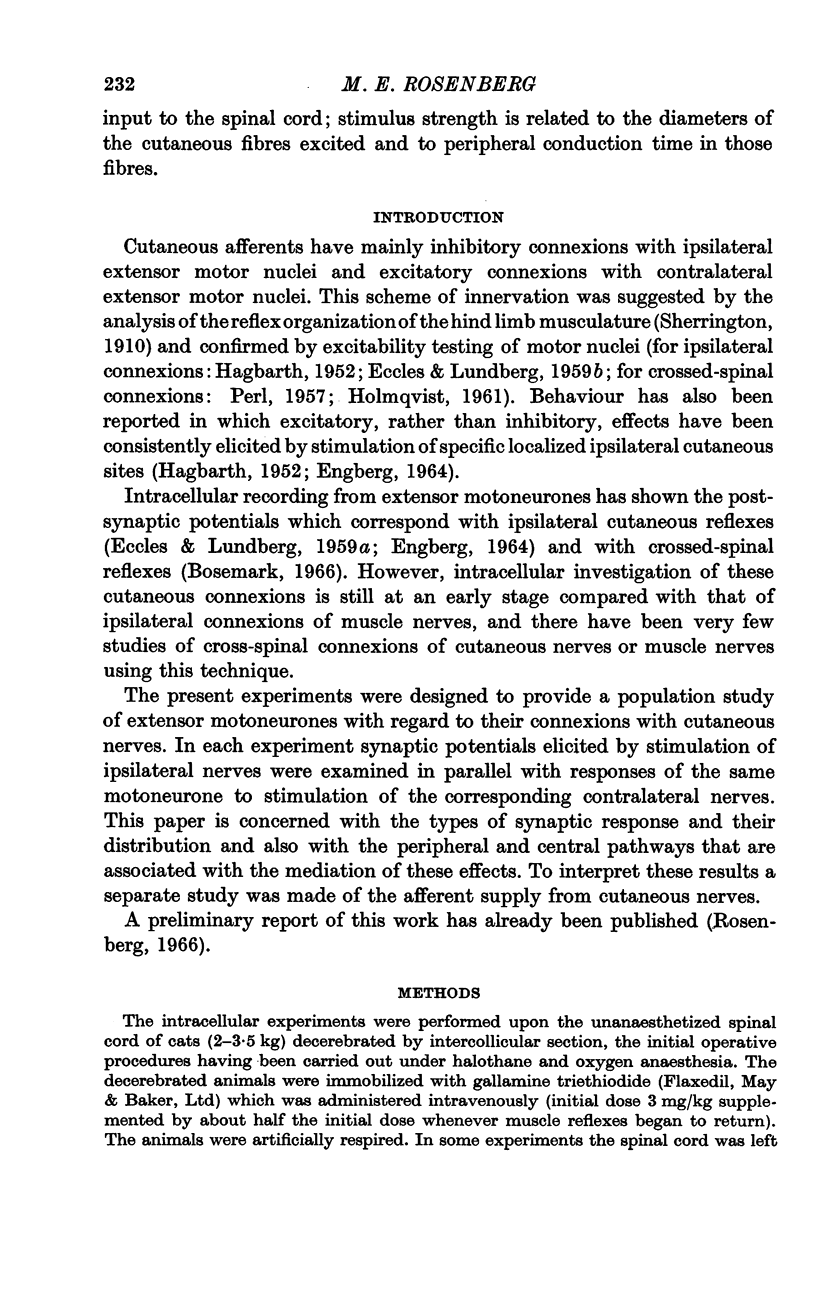
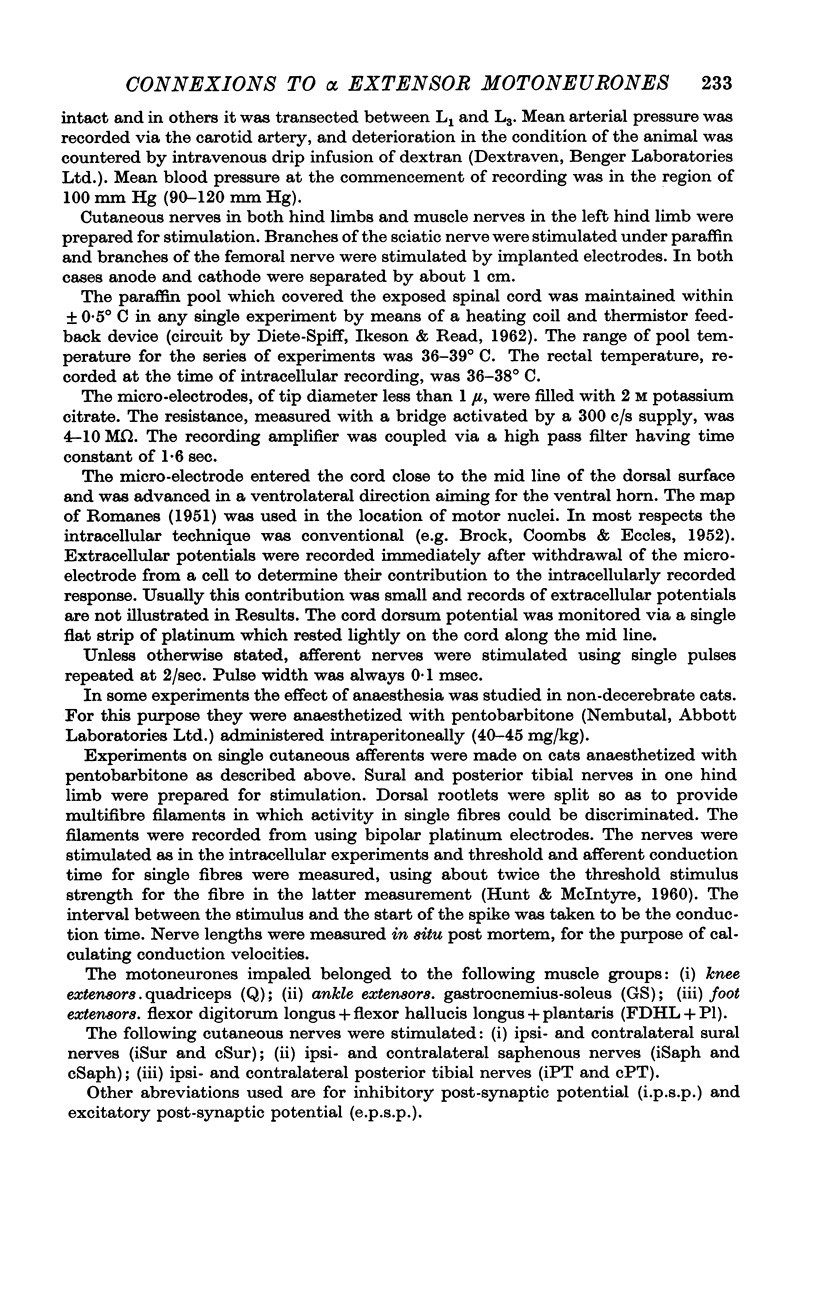

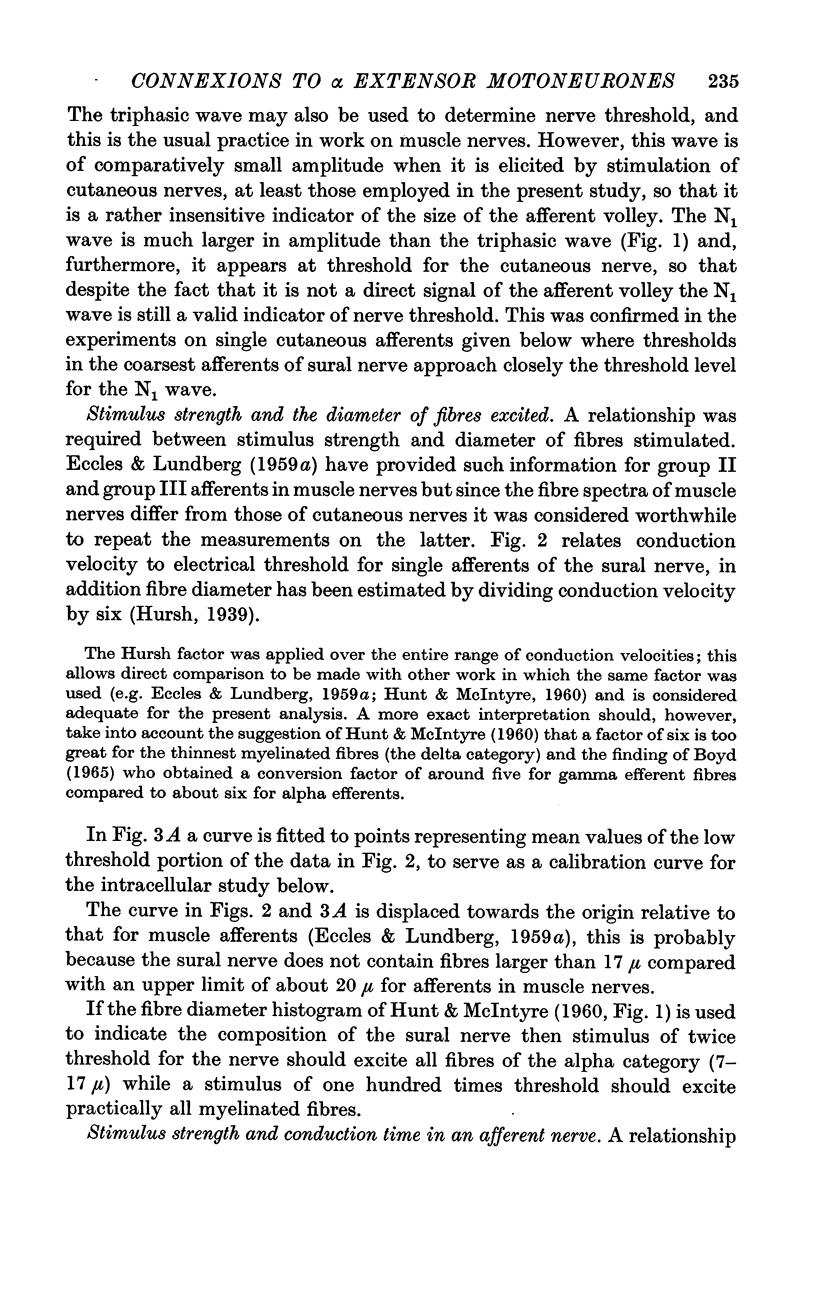







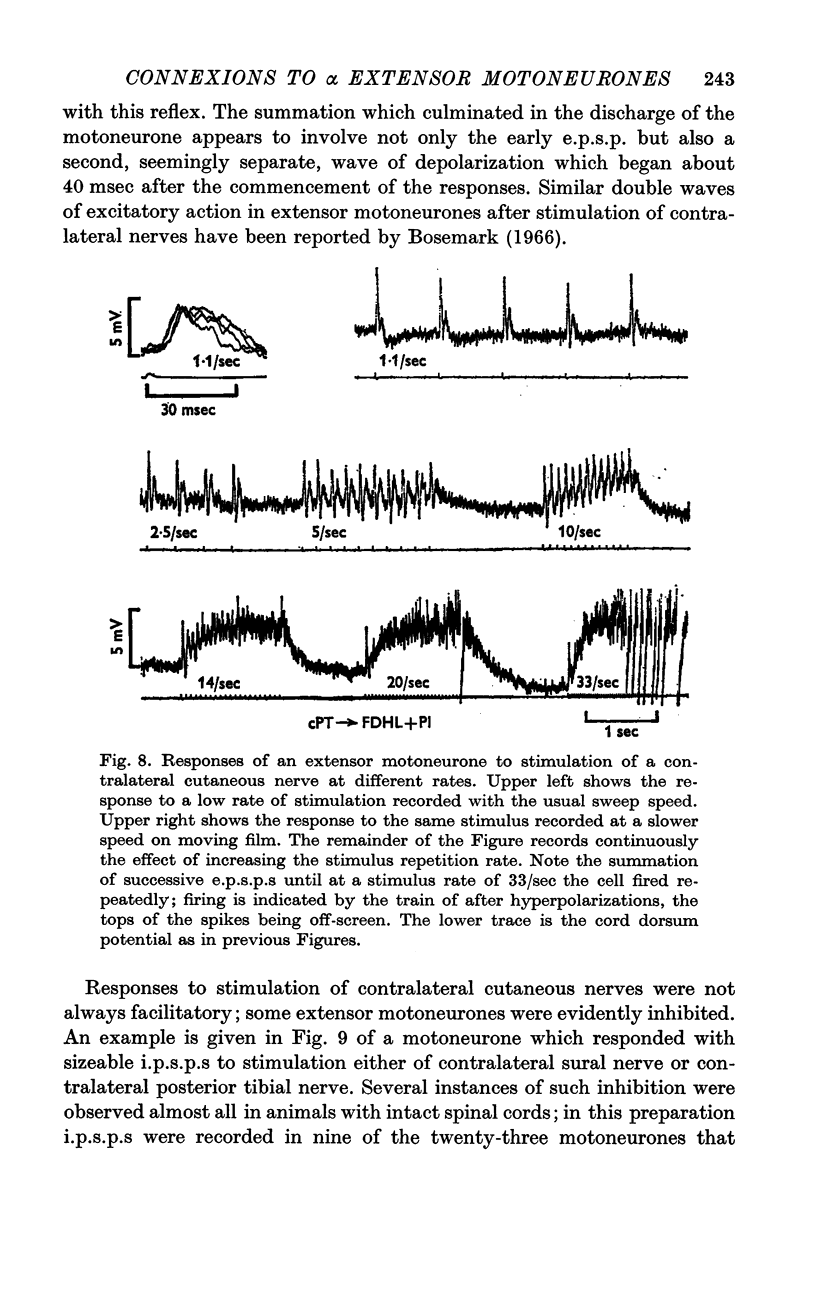






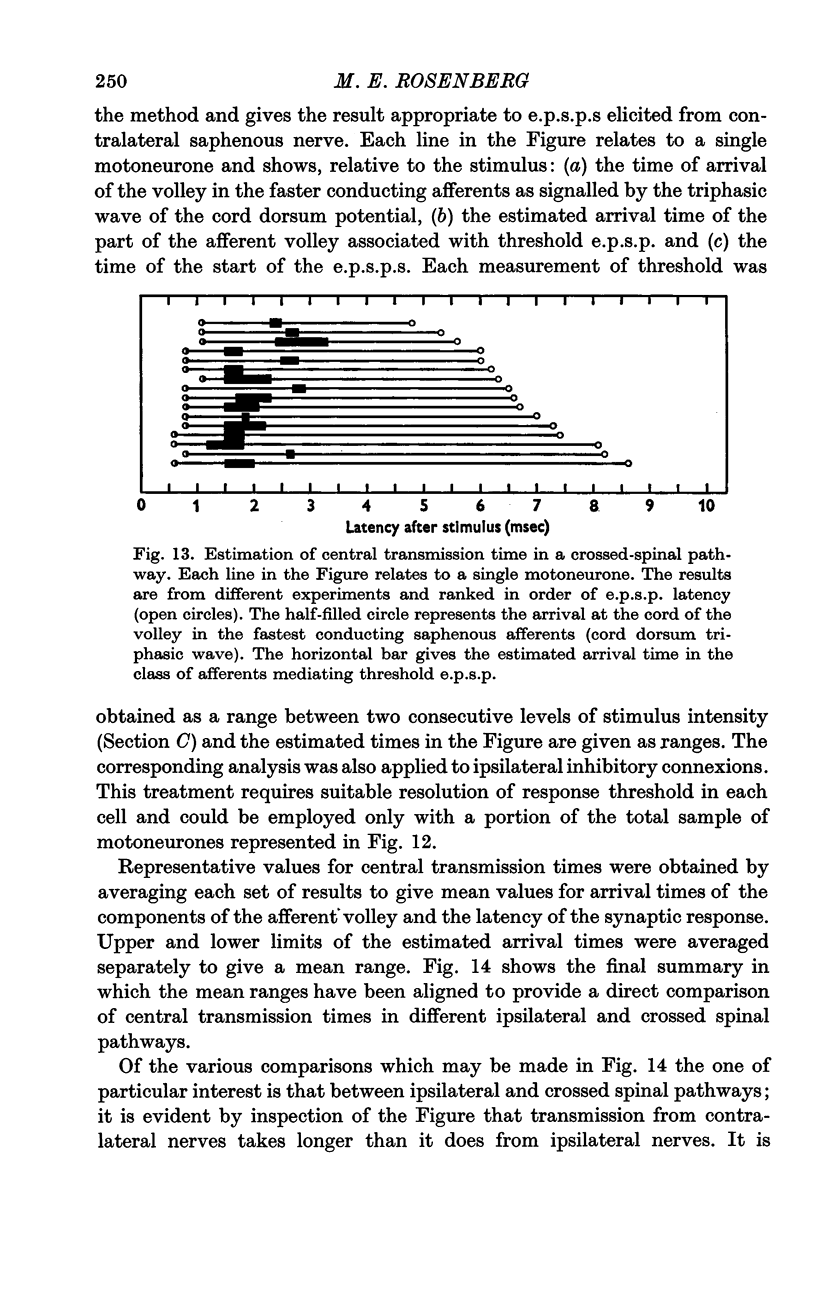





Selected References
These references are in PubMed. This may not be the complete list of references from this article.
- BROCK L. G., COOMBS J. S., ECCLES J. C. The recording of potentials from motoneurones with an intracellular electrode. J Physiol. 1952 Aug;117(4):431–460. doi: 10.1113/jphysiol.1952.sp004759. [DOI] [PMC free article] [PubMed] [Google Scholar]
- Brown T. G., Sherrington C. S. The rule of reflex response in the limb reflexes of the mammal and its exceptions. J Physiol. 1912 May 6;44(3):125–130. doi: 10.1113/jphysiol.1912.sp001504. [DOI] [PMC free article] [PubMed] [Google Scholar]
- Burgess P. R., Perl E. R. Myelinated afferent fibres responding specifically to noxious stimulation of the skin. J Physiol. 1967 Jun;190(3):541–562. doi: 10.1113/jphysiol.1967.sp008227. [DOI] [PMC free article] [PubMed] [Google Scholar]
- CREESE R., D'SILVA J. L., SHAW D. M. Interfibre fluid from guinea-pig muscle. J Physiol. 1962 Jun;162:44–53. doi: 10.1113/jphysiol.1962.sp006913. [DOI] [PMC free article] [PubMed] [Google Scholar]
- DOUGLAS W. W., RITCHIE J. M. Nonmedullated fibres in the saphenous nerve which signal touch. J Physiol. 1957 Dec 31;139(3):385–399. doi: 10.1113/jphysiol.1957.sp005899. [DOI] [PMC free article] [PubMed] [Google Scholar]
- ECCLES J. C., ECCLES R. M., IGGO A., ITO M. Distribution of recurrent inhibition among motoneurones. J Physiol. 1961 Dec;159:479–499. doi: 10.1113/jphysiol.1961.sp006822. [DOI] [PMC free article] [PubMed] [Google Scholar]
- ECCLES J. C., ECCLES R. M., LUNDBERG A. Synaptic actions on motoneurones caused by impulses in Golgi tendon organ afferents. J Physiol. 1957 Sep 30;138(2):227–252. doi: 10.1113/jphysiol.1957.sp005849. [DOI] [PMC free article] [PubMed] [Google Scholar]
- ECCLES J. C., ECCLES R. M., LUNDBERG A. Types of neurone in and around the intermediate nucleus of the lumbosacral cord. J Physiol. 1960 Nov;154:89–114. doi: 10.1113/jphysiol.1960.sp006566. [DOI] [PMC free article] [PubMed] [Google Scholar]
- ECCLES R. M., LUNDBERG A. Supraspinal control of interneurones mediating spinal reflexes. J Physiol. 1959 Oct;147:565–584. doi: 10.1113/jphysiol.1959.sp006262. [DOI] [PMC free article] [PubMed] [Google Scholar]
- FERNANDEZ DE MOLINA A., GRAY J. A. Activity in the dorsal spinal grey matter after stimulation of cutaneous nerves. J Physiol. 1957 Jun 18;137(1):126–140. doi: 10.1113/jphysiol.1957.sp005801. [DOI] [PMC free article] [PubMed] [Google Scholar]
- KATZ B., MILEDI R. A STUDY OF SPONTANEOUS MINIATURE POTENTIALS IN SPINAL MOTONEURONES. J Physiol. 1963 Sep;168:389–422. doi: 10.1113/jphysiol.1963.sp007199. [DOI] [PMC free article] [PubMed] [Google Scholar]
- LLOYD D. P. Input-output relation in a flexor reflex. J Gen Physiol. 1957 Nov 20;41(2):297–306. doi: 10.1085/jgp.41.2.297. [DOI] [PMC free article] [PubMed] [Google Scholar]
- MARK R. F., STEINER J. Cortical projection of impulses in myelinated cutaneous afferent nerve fibres of the cat. J Physiol. 1958 Aug 6;142(3):544–562. doi: 10.1113/jphysiol.1958.sp006035. [DOI] [PMC free article] [PubMed] [Google Scholar]
- MARUHASHI J., MIZUGUCHI K., TASAKI I. Action currents in single afferent nerve fibres elicited by stimulation of the skin of the toad and the cat. J Physiol. 1952 Jun;117(2):129–151. doi: 10.1113/jphysiol.1952.sp004736. [DOI] [PMC free article] [PubMed] [Google Scholar]
- PERL E. R. Crossed reflexes of cutaneous origin. Am J Physiol. 1957 Mar;188(3):609–615. doi: 10.1152/ajplegacy.1957.188.3.609. [DOI] [PubMed] [Google Scholar]
- ROMANES G. J. The motor cell columns of the lumbo-sacral spinal cord of the cat. J Comp Neurol. 1951 Apr;94(2):313–363. doi: 10.1002/cne.900940209. [DOI] [PubMed] [Google Scholar]
- Sherrington C. S. Flexion-reflex of the limb, crossed extension-reflex, and reflex stepping and standing. J Physiol. 1910 Apr 26;40(1-2):28–121. doi: 10.1113/jphysiol.1910.sp001362. [DOI] [PMC free article] [PubMed] [Google Scholar]
- Zotterman Y. Touch, pain and tickling: an electro-physiological investigation on cutaneous sensory nerves. J Physiol. 1939 Feb 14;95(1):1–28. doi: 10.1113/jphysiol.1939.sp003707. [DOI] [PMC free article] [PubMed] [Google Scholar]


